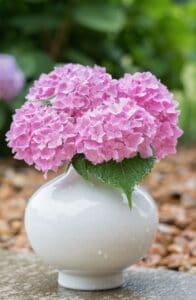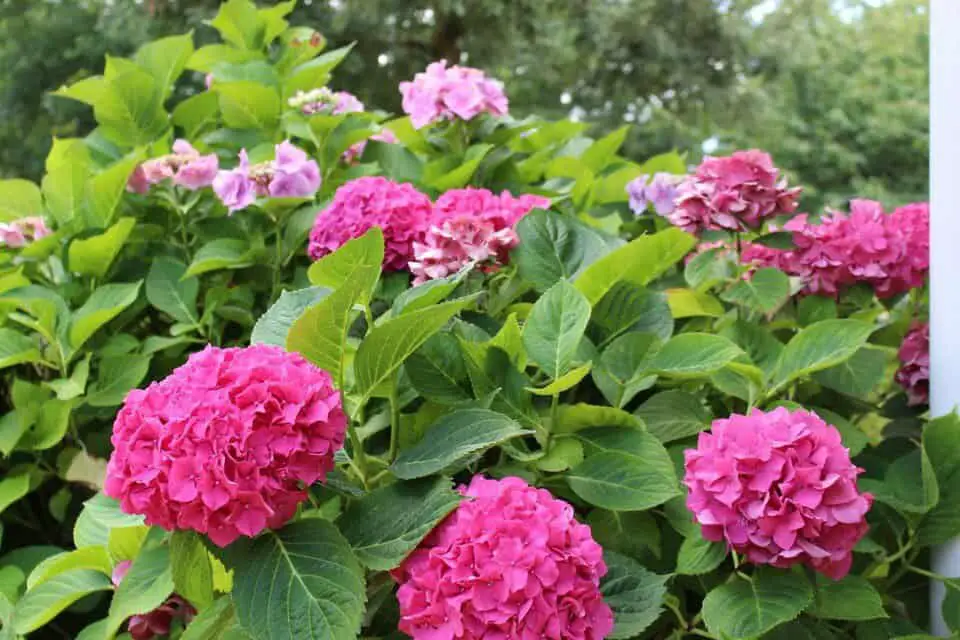Some links in the post are affiliate links and I get a commission from purchases made through some links found in the post.
Hydrangeas are the main and most beautiful part of many gardens. Not only are they amazing plants, but It’s difficult to go wrong with big, lovely bushes that bloom in a variety of hues that really enjoy some shade.
You may want to transplant the hydrangea for various reasons. However, whatever the motivation, moving hydrangeas can be a simple process once you know what to do and when to replant them.
One of the best periods to transplant hydrangea is right before they are dormant. This is after the majority of their leaves have dropped in the fall.
It is important to transplant hydrangea at the proper time, because this way, you will make sure that they will be happy and thrive.
It’s crucial to plant hydrangeas in the proper spot and give them proper watering. The right location can make a significant difference and will provide beautiful shrubs and blooms.
Therefore, there are some important things you need to know before you transplant hydrangea. In this article, we will discuss all you need to know for successful transplantation.
When to Transplant a Hydrangea
 As long as you transplant hydrangeas at the proper time, they will most likely thrive. However, relocating a plant always has the danger of overstressing it and killing it, so be sure the new location is appropriate.
As long as you transplant hydrangeas at the proper time, they will most likely thrive. However, relocating a plant always has the danger of overstressing it and killing it, so be sure the new location is appropriate.
It is better to transfer them when they are dormant. If you live in a warmer place, you may usually transplant them throughout the winter when the ground is not yet frozen. In a cooler environment, this happens most frequently in the fall.
You can transplant hydrangea successfully in the spring, prior to the initial growth spurt.
Since the plants will soon emerge from their hibernation period and settle in for the new season, this may be an excellent time to transfer them.
In colder climates with the hardiness zones of 4 to 6, from the middle to late spring is a decent period to transplant a hydrangea.
However, in the warmer climate zones of 7 to 9, it is recommended to be transplanted in the early spring, between March and April.
In general, it’s not a good idea to transplant hydrangeas during the hottest months of the year, although it is conceivable if it is necessary.
If there is a heat wave or a drought, don’t relocate your hydrangea. Those plants are struggling to adapt to the new location if there is a lack of moisture and not enough hydration.
How to Transplant a Hydrangea
When you decide to transplant hydrangea, Pick a spot where your hydrangea will be able to grow and become full-sized without being pruned.
For hydrangeas of average size, aim for a height of at least 4 feet by 4 feet. It is very hard to keep hydrangeas clipped to a size that is smaller than what they eventually want to grow.
First of all, dig up your hydrangea carefully and make sure to take out as large a portion of the rootball as possible. To release the root ball, move your shovel in a circular motion around the bush.
It can take many people and a crowbar to get a large and hefty hydrangea root ball out of the ground.
You might need some assistance with this because the plant may have a heavy weight due to the fibrous roots that create a ball loaded with dirt.
transplant hydrangeas in a spot that receives afternoon shade. In addition to ensuring the plant’s survival, this is also where hydrangeas love to grow, particularly in the South. Plant in soil that drains properly.
Dig a hole in your yard that is just a little bit larger than the root ball you are planning to place in it. Then easily put the soil around the rootball.
Cover the area with dirt, and saturate the root ball completely. It is recommended to spread several inches of compost around the hydrangea.
If you transplant your hydrangeas when they are dormant, which is the ideal time to do so, water them well once. They might not require any more water until spring when the weather will warm up.
After being transplanted, hydrangeas need to be kept extremely hydrated during the first and second-year summers. To water, use a hose as opposed to a sprinkler system.
Do not, however, overwater. Try to avoid overwatering and dehydration of the plant, daily watering or letting the plants dry out can both be harmful.
If the soil is sufficiently dry and the leaves begin to wilt, spray them every day until they begin to recover.
Avoid letting the soil remain wet around the hydrangeas, especially if the soil drainage is poor. This is particularly true for oakleaf hydrangeas, which can quickly decay if they are placed in moist soil.
Tips for Transplanting a Hydrangea
 Planting hydrangeas near a tree frequently results in their death. This is due to the fact that tree roots are very invasive and are lured to the rich, wet soil that hydrangeas are often grown in.
Planting hydrangeas near a tree frequently results in their death. This is due to the fact that tree roots are very invasive and are lured to the rich, wet soil that hydrangeas are often grown in.
Therefore, large plants can take away the needed nutrients and moisture.
The roots will all grow back within a year, no matter how many you cut off to create a way for the hydrangeas (but be cautious not to cut too many off or you’ll destroy the tree!).
Hydrangeas sometimes don’t grow well beneath big hardwood trees because of insufficient light. Hydrangeas are unlikely to flourish where grass does not look good either.
The Oakleaf hydrangea is more fickle than the other varieties when it comes to water retention. Make sure the place where the oakleaf is planted has excellent drainage, or otherwise, their roots may start to rot.
Especially when they are newly transplanted they require attention and proper watering. The oakleaf is relatively simple to care for once it has established itself.
What to Look out for After you have Transplanted a Hydrangea
Plant relocation frequently results in transplant shock. Falling leaves, withering plants, and unblooming hydrangeas are all warning indicators.
If the damage is severe, your plant could not recover. The danger of transplant shock from hydrangeas can be reduced by removing the root ball and dirt around it as you can. According to Searle, too much root injury might be lethal.
Even though pruning of hydrangea is important, you should avoid doing it now since it can put the plant under too much stress.
Make sure to water your hydrangea often as it adjusts to its new location. You can be certain that the hydrangea has been successfully transplanted once it begins to bloom.
If the soil is too dry, then the hydrangea will have to fight for its life. Heavy soil that has a high amount of clay in it can cause many complications.
However, if you have such soil in the garden and can not do anything, you can make it softer by adding roughage such as pine bark mulch.
Final Thoughts
 In this article, we discussed when to transplant a hydrangea. Generally, the hydrangeas have to be transplanted either in the fall or in the spring.
In this article, we discussed when to transplant a hydrangea. Generally, the hydrangeas have to be transplanted either in the fall or in the spring.
However, it is recommended to wait for the cooler weather, so the newly transplanted hydrangea will go to the dormant stage and does not have to struggle to both accommodate and produce new foliage and buds.
November is the perfect time of year if you live in a colder area since the bush is dormant in that period and the dirt has not been frozen yet.
However, if you live in an area where the climate is warm, then you can transplant a hydrangea in December or even February.
As long as you don’t do it in the midst of the summer’s sweltering heat, you may potentially move in at any time of the year and the plant will not have a problem.


